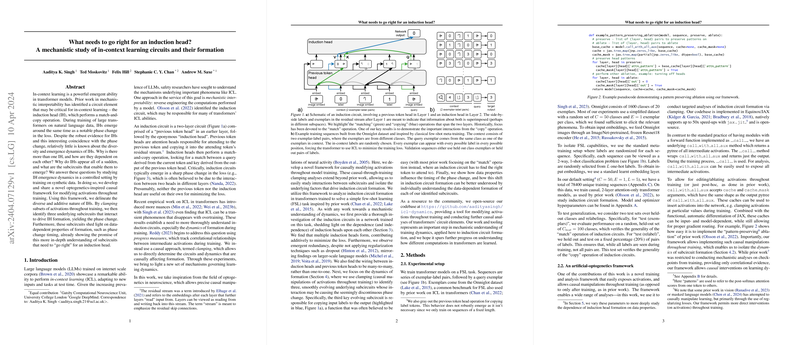Mechanistic Study of In-context Learning Circuits in Transformers
Induction Head Formation in Transformers
The paper examines the mechanistic underpinnings of in-context learning (ICL) abilities in transformer models by focusing on the emergence and functionality of induction heads (IH). IHs are identified as critical circuit elements facilitating the ICL phenomenon, wherein a model exhibits the ability to adapt to new tasks or inputs without explicit retraining. This phenomenon usually manifests through a sharp phase change in the model's loss, associated with the emergence of IHs. The research addresses several pivotal questions regarding IHs, including their diversity, their sudden emergence, the developmental dynamics, and the subcircuits enabling their manifestation.
Novel Experimental Framework
A key contribution of this paper is the introduction of a novel experimental framework, inspired by optogenetics, which facilitates causal manipulations of activations throughout the training of models. This "clamping" method allows for unprecedented exploration into the mechanics of IH emergence and their functionality. By modifying activations via this method, the paper dissects the transformer learning process into more granular, manipulatable elements, offering new insights into the diverse and additive nature of IHs.
Dynamics of Induction Circuit Formation
The paper explores the formation dynamics of induction circuits, exploiting the clamping method to unravel the interactions of subcircuits contributing to IH formation. The emergence of IHs is shown to be driven by three distinct, yet interconnected, subcircuits, challenging the previous understanding that focused mainly on the matching operation of IHs. This nuanced dissection not only highlights the complexity behind ICL but also points to the additive participation of multiple heads in this process. Furthermore, the analysis reveals a many-to-many relationship between induction heads and previous token heads, contradicting the previously assumed one-to-one wiring.
Implications and Applications
Practically, the paper's insights into the additive nature of induction circuits illuminate potential optimization pathways for transformer models, notably in the context of ICL. Understanding the distinct roles and cooperative dynamics of various subcircuits paves the way for more efficient model designs, potentially enhancing their learning speed and generalization capabilities. Theoretically, the research advances the discourse on mechanistic interpretability, offering a robust framework for future studies to causally dissect the learning dynamics of complex machine learning models.
Future Directions in AI Research
Looking forward, the mechanistic insights and the experimental toolkit developed in this paper have broad implications for the domain of AI interpretability and model optimization. As the complexity of AI systems, especially LLMs, continues to escalate, the ability to causally intervene and understand the intricacies of model behavior becomes indispensable. This work not only propels forward our understanding of IH-related phenomena in transformers but also sets a precedent for future investigations into other emergent model behaviors.
In summary, this paper represents a significant stride in the mechanistic interpretability of LLMs, especially concerning the phenomenon of in-context learning. Through a combination of innovative experimental methods and detailed analysis, it provides a fresh perspective on the complexity of learning dynamics within transformers. The implications of this research extend beyond the theoretical, promising avenues for enhancing model efficiency and effectiveness.
